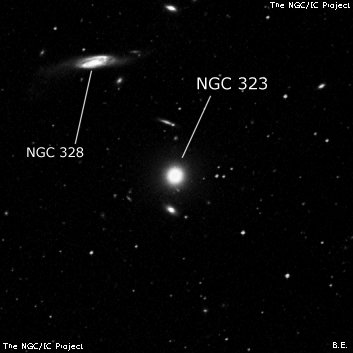
ESO 151-012, situated 7.3' SSE, appeared fairly bright, moderately large, elongated 2:1 WNW-ESE, ~50"x25", sharply concentrated with a bright core and stellar nucleus. A mag 15 star is 1.5' SE and a mag 15.5 star is 1' N. ESO 151-012 is located 10' NE of mag 6.6 HD 5474 and I'm surprised that John Herschel missed it. Just 2' E of the bright star is ESO 151-004. This galaxy appeared fairly faint to moderately bright, very elongated 7:2 NNW-SSE, contains a slightly brighter elongated core. A mag 14.5-15 star is at the south tip, 45" from center. The nearby mag 6.6 star detracts from the view.
John Herschel discovered NGC 323 = h2365 on 3 Oct 1834 and recorded "vF, S, R. The RA may err several seconds. The PD also is not very good." On a much later sweep he recorded "Viewed; found exactly in the place of No 29, Sweep 498 [previous description] pB, S, R, bM, 15 arcseconds, there is also another [NGC 328], pos = 36.8 degrees [NE], delta in PD = 4'." JH's RA is 0.1 tmin too large.
600/800mm - 30" (10/13/15 - OzSky): at 394x; fairly bright, fairly small, round, high surface brightness, 40" diameter, very small bright core. In a group of galaxies (8 recorded in a 25' string N-S) with NGC 328 4' NE and ESO 151-010 4.7' N. Forms a very close pair with PGC 95384 1.0' S. The close companion (not catalogued in Megastar) is faint, very small, slightly elongated, 15"x10", low surface brightness.
Notes by Steve Gottlieb